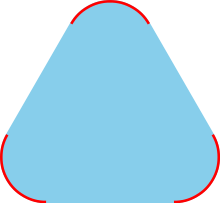Krein–Milman theorem

In the mathematical theory of functional analysis, the Krein–Milman theorem is a proposition about convex sets in topological vector spaces. A particular case of this theorem, which can be easily visualized, states that given a convex polygon, one only needs the corners of the polygon to recover the polygon shape. The statement of the theorem is false if the polygon is not convex, as then there can be many ways of drawing a polygon having given points as corners.
Formally, let be a locally convex topological vector space (assumed to be Hausdorff), and let be a compact convex subset of . Then, the theorem states that is the closed convex hull of its extreme points.
The closed convex hull above is defined as the intersection of all closed convex subsets of that contain This turns out to be the same as the closure of the convex hull in the topological vector space. One direction in the theorem is easy; the main burden is to show that there are 'enough' extreme points.
The original statement proved by Mark Krein and David Milman was somewhat less general than this.
Hermann Minkowski had already proved that if is finite-dimensional then equals the convex hull of the set of its extreme points. The Krein–Milman theorem generalizes this to arbitrary locally-convex , with a caveat: the closure may be needed.
Relation to the axiom of choice
The axiom of choice, or some weaker version of it, is needed to prove this theorem in Zermelo–Fraenkel set theory. This theorem together with the Boolean prime ideal theorem, though, can prove the axiom of choice.
Related results
Under the previous assumptions on if is a subset of and the closed convex hull of is all of , then every extreme point of belongs to the closure of This result is known as Milman's (partial) converse to the Krein–Milman theorem.
The Choquet–Bishop–de Leeuw theorem states that every point in is the barycenter of a probability measure supported on the set of extreme points of
Theo Buehler proved in 2006 that the Krein–Milman theorem also holds for CAT(0) spaces. [1]
See also
- Carathéodory's theorem (convex hull)
- Shapley–Folkman lemma
- Helly's theorem
- Radon's theorem
- Choquet theory
- Banach–Alaoglu theorem
References
- M. Krein, D. Milman (1940) On extreme points of regular convex sets, Studia Mathematica 9 133–138.
- Milman, D. (1947). Характеристика экстремальных точек регулярно-выпуклого множества. Doklady Akademii Nauk SSSR (in Russian). 57: 119–122.
{{cite journal}}: Unknown parameter|trans_title=ignored (|trans-title=suggested) (help) - H. L. Royden. Real Analysis. Prentice-Hall, Englewood Cliffs, New Jersey, 1988.
- N. K. Nikol'skij (Ed.). Functional Analysis I. Springer-Verlag, 1992
- H. Minkowski. Geometrie der Zahlen. Teubner, Leipzig, 1910
This article incorporates material from Krein–Milman theorem on PlanetMath, which is licensed under the Creative Commons Attribution/Share-Alike License.






